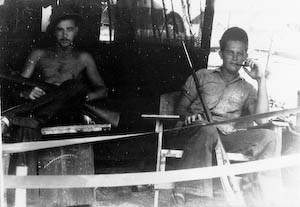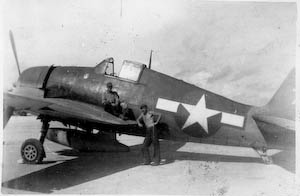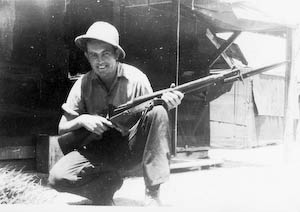During World War Two, Dad served in the US Navy CASU 35 unit. Over the years, Dad told me some stories about what his unit did during the war. I recently found this article taken from the August 1945 issue of Our Navy magazine. It explains in detail how important the CASU units were in our military offensives in the South Pacific. The images included with this article are Dad’s original photos of his unit, CASU 35.
This article reprinted from Wartime Press
Our Coral Carriers Helped Turn the Tide of Battle
By Vern A. Miller
Air power has been the deciding factor in our crushing offensive against the Japs in the Pacific. Our big, ungainly, teak-topped ships have furnished the one-two punch that, time and time again, has sent the Japs reeling into a corner. And the miracle of our sustained attack from the air must have loomed as black magic to the frenzied Admirals of the Rising Sun. For in the unrelenting pressure we were able to exert, there was evidence that the American Navy was in possession of a secret that gave our roving fleets an endurance beyond anything heretofore possible in the realm of logistics.
Somewhere, the Japs must have reasoned, America had stacked the deck against them. How could our carriers remain at sea month after month with no decline in hitting power? How could our planes go through strike after strike, month after month of constant flying, and still maintain top efficiency? Did our machines never wear out? Were American airmen immune to battle fatigue?
The answer to this seeming mystery would have been immediately apparent to our enemy if he could have been accorded the privilege of visiting one of the islands we had so recently taken from him. Here, where only weeks before had been swamp and jungle or ridged and pot-holed coral structure, stretched the long, smooth trigonometric pattern of runways. Hangars, revetments, supply buildings, and all the other facilities for storage, repair and upkeep of planes, huddled about the bomber-length takeoff strips.
These were our unsinkable carriers, our island flattops, the miracle behind our overwhelming Pacific offensive. Without these air bases at strategic points, our carriers would have been unable to range from the Kuriles to the Spice Islands, up and down and through the seas that Japan had thought were closed to enemy power.
But there is more to the secret than mere air bases. Behind those air fields and the vital role they have played in Pacific warfare, is the story of two Navy outfits that came, full fledged, from our secret councils of war. They were the CASUs and the Acorns. Until recently these units were on the hush-hush list, but our mounting success has released them from the shrouding blanket of security, and their story can at last be told.
To understand, fully, the importance of these units, we must go back to the beginning of Naval aviation.
World War II brought swift development of military aircraft. These aircraft, and the personnel handling them, were used in an excellent manner by the formation of squadrons which were composed of both the flight crews and ground men all in one large unit.
For this period the arrangement was adequate for full efficiency. The squadrons were fairly mobile, and it was seldom necessary to move an entire unit from one airfield to another swiftly. With the advent of Naval aviation, the same thing held true.
In the years from 1920 to the present war, squadrons were assigned to our few aircraft carriers, complete in all details. When it was not necessary for the squadrons to remain aboard ship, they picked up, bag and baggage, spare aircraft parts and material as well as personnel, and moved ashore to some Naval Air Station. There they maintained their regular flying routine dive bombing, gunnery, tactics, and the other training procedures until they were again required aboard their ships.
While on the air station, they operated as a complete unit with all the necessary technicians required to maintain the aircraft in combat readiness.
When the fast paced and swiftly moving war descended upon us in December 1941, squadrons in a complete unit, proved to be too immobile it became quite evident that the old system of squadron operation would not be feasible. Whenever the squadrons embarked, or when they disembarked, there entailed shifting large groups of men and tons upon tons of material needless waste of manpower and time. This also proved to be the case whenever an aircraft carrier made port for any length of time and when it was still necessary for the pilots to continue their flying to keep themselves and airplanes in top combat condition. Men and material had to be shifted from the ship to the air station to maintain these aircraft.
 The squadrons were cumbersome arrangements of aircraft and men, and something had to be done about it in a hurry. And as always, the Navy came through with the answer.
The squadrons were cumbersome arrangements of aircraft and men, and something had to be done about it in a hurry. And as always, the Navy came through with the answer.
Compact maintenance units were formed, called Carrier Aircraft Service Units (abbreviated to CASU) and Patrol Aircraft Service Units (abbreviated to PATSU). As the names imply, the CASUs were primarily for the purpose of maintaining carrier type of aircraft; the PATSU handled the maintenance of patrol type of aircraft, usually the large PBY Catalina flying boats and the Lockheed PV Venturas. Fundamentally the two units are the same, so hereafter only the CASU will be considered.
The nucleus of the CASU is made up of all the aviation ratings of the Navy: Aviation Machinist’s Mates, Aviation Machinist’s Mates with special jobs and designations such as Propeller, Instrument, Carburetor, and Hydraulic; Aviation Radiomen, Aviation Radarmen, Aviation Radio Technicians, Aviation Electricians, Aviation Painters, Aviation Ordnancemen, Aviation Metalsmiths, as well as the usual General Service ratings necessary to all naval establishments such as Yeomen, Storekeepers, Machinist’s Mates, Cooks, Bakers, et cetera. The officers, both Regular Navy and Naval Reserve, are specialists in aviation. The Commanding Officer is usually a designated Naval Aviator.
In the case of the CASU, when it is set up on an air station or an island air strip and functioning, whenever an aircraft carrier’s airplanes fly in for a few days operations, it is quite unnecessary for them to bring maintenance personnel with them the CASU handles all this.
These compact units are able to be moved to outlying bases usually landing on the South Pacific islands shortly after the Japs have been driven off. Scuttlebutt has it that in one case they even went in with the Marines and it is easy to believe.
To further streamline this phase of naval aircraft operations, the aircraft carriers themselves set up an air department sufficient in size to maintain the aircraft when they are onboard. This air department operates not unlike the manner in which the CASU operates ashore.
The type of work performed by the various CASUs vary in a number as great as the number of CASUs themselves, each performing duties cognizant with the area in which they are operating.
However, duties of the CASUs can be divided into three complete main groups the supply and maintenance of active combat squadrons, the supply and maintenance and training of squadrons heading overseas, and the setting up of an aircraft pool in the forward area from which actively operating combat squadrons and aircraft carriers may draw replacement aircraft to replace their losses in combat.
For the first group, when they are set up and operating, the squadrons land on the field with only flight personnel. It is then up to the CASU to maintain the squadrons’ aircraft in a complete flyable condition, performing regular periodic inspections called “checks” that are outlined for all Naval Aircraft by the Bureau of Aeronautics. This calls for a periodic check on all parts of the aircraft, including the structural members and all their component operating parts as well as the engine and all of its accessories such as its magneto, starter, generator, fuel and hydraulic pumps, spark plugs, and carburetor.
Further, the accessories of the aircraft itself must have a thorough going over, and CASU personnel check radio and radar gear, guns, turrets, and ammunition. It takes many competent specialists to keep an aircraft in the air, and the CASUs have all types.
The second group performs all the work of the first in keeping the squadrons’ planes in the air, but in addition they also help the squadrons to form, and literally speaking, set them off on the right foot.